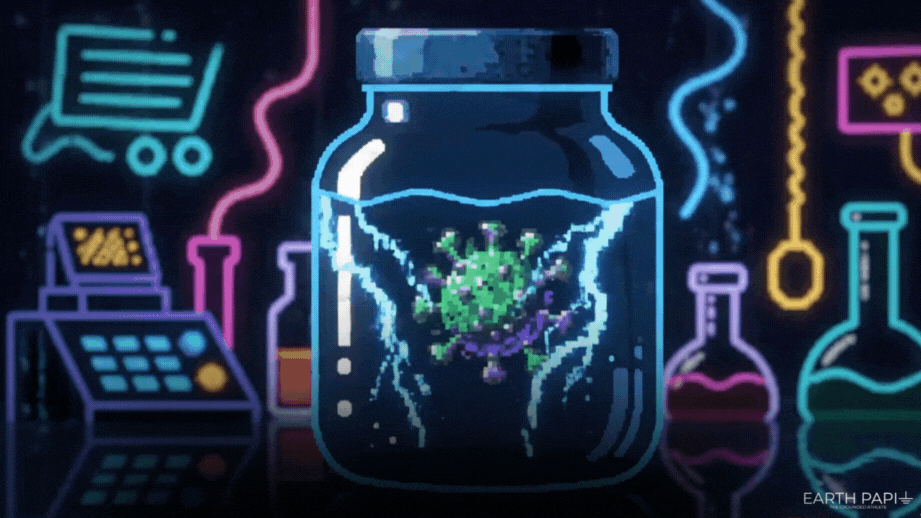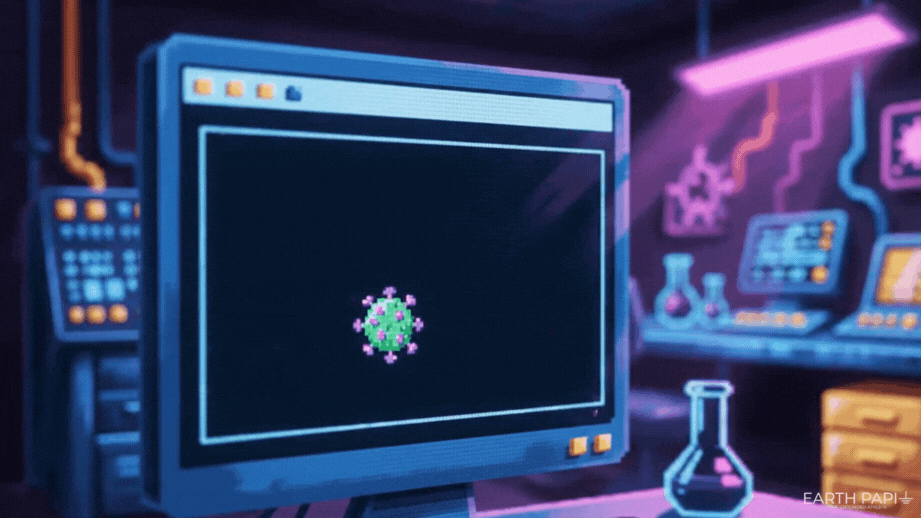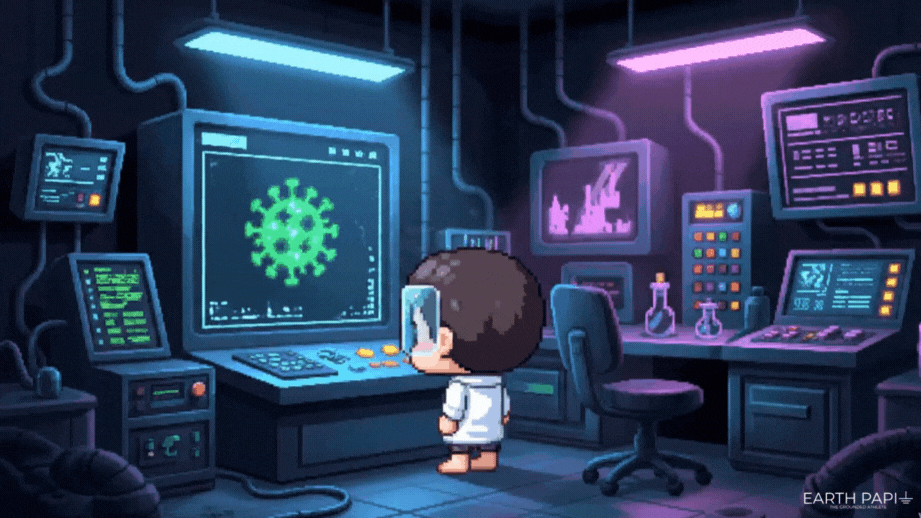Earth & Immune Series Part 7 - Grounding & Viral Infection (the Finale)
In 2022, researchers at the University of Basrah College of Medicine conducted a study led by Dr. Haider Abdul-Lateef Mousa. The goal was to investigate whether grounding, the practice of direct contact with the Earth, could help prevent or treat COVID-19.
Viruses are not alive in the traditional sense. They are packets of genetic material, DNA or RNA, surrounded by a protein coat. They can't reproduce on their own. To replicate, they invade living cells and hijack the host's cellular machinery. Some viruses are benign. Some are helpful. Others are lethal. The air we breathe and the surfaces we touch are full of them. They're part of our ecosystem, forming what’s known as the human virome.
Some viruses in the gut help regulate bacterial populations. Others have become embedded in our DNA over evolutionary time, contributing to important functions like placenta formation. Exposure to viruses, especially early in life, helps train the immune system and build memory.
COVID-19, caused by the SARS-CoV-2 virus, is a single-stranded RNA virus. It binds to ACE2 receptors on human cells via its spike protein. Symptoms range from none at all to respiratory failure and multi-organ death.
One of the drivers of severe outcomes is a cytokine storm. This occurs when the immune system overreacts and floods the body with inflammatory molecules, including interleukin-6 (IL-6). IL-6 is normally helpful, but when overproduced, it can spiral into a dangerous feedback loop. The result is tissue damage, organ failure, and death.
Grounding may offer a counter to this. Previous studies highlighted in that past few series I’ve done showed that grounding reduces inflammatory markers and helps regulate immune responses. That laid the foundation for this COVID-19 study.
In the Basrah trial, 71 patients with COVID-19 participated. Grounding was used both preventively and therapeutically. Patients either touched the Earth directly or used grounding systems for 15 minutes to 6 hours daily.
Results were striking. 69 of the 71 patients showed improvement within 2 hours to 11 days. Median illness duration was 9 days. That’s shorter than the 14-day median reported by WHO for mild cases, and much shorter than the 21–42 day median for severe ones. One patient with a blood oxygen level of just 38% rebounded to 95% (on oxygen) and 77% (off oxygen) after two 3-hour grounding sessions.
Grounding improved fever, fatigue, breathing, appetite, headaches, and other symptoms. Among those grounded before infection, symptoms were generally milder. Deaths were higher in families where individuals had no contact with the Earth.
COVID-19 is also associated with coagulopathy (abnormal blood clotting). Grounding affects blood viscosity and charge, reducing clot risk. Hypoxemia, another deadly complication of COVID-19, was also improved by grounding, as shown by real-time increases in blood oxygenation.
The second study, published in 2020, explored something unusual, how grounding affects the pH of the respiratory tract. This matters. Enveloped viruses like SARS-CoV-2 rely on acidic environments to fuse with host cells. They often use endosomes, small intracellular transport vesicles, to enter and replicate. These endosomes are acidic. That acidity helps the virus uncoat and release its RNA.
Grounding changed that. In the study, average respiratory tract pH rose from 5.83 to 6.33 after grounding. That may seem small, but it's significant. A higher (less acidic) pH inhibits viral entry. Grounding created a shift in electric potential that influenced this internal environment. The body, acting like a capacitor, accumulated negative charge. This influenced membrane behavior, enzyme function, and the balance of hydrogen ions.
The lungs act as natural ionizers. Exhaled breath releases negative hydroxyl ions, but only if the body has enough electrons. Without grounding, that supply drops. Humidity also plays a role. High humidity and temperature (>95% and 38°C) reduce viral viability. Low humidity makes respiratory tissues more vulnerable to infection and damage.
Acidification of the airway reduces antimicrobial defense and increases bacterial co-infection risk. This is especially problematic during respiratory viral infections, which often pave the way for bacterial invasion.
By altering the electrostatic potential and pH of the airway, grounding may reduce the likelihood of both viral and bacterial infection. Grounding also counteracts the charge imbalance that occurs through breathing. Without grounding, each breath makes the body more positively charged. Eventually, the body retains exhaled negative ions instead of releasing them.
To sum it up: the first study found that grounding shortened illness duration and improved oxygenation and symptoms. The second found that grounding altered respiratory pH and charge in a way that could block viral entry. Both support the idea that grounding may reduce infection severity and improve immune response.
So we end the Earth & Immune series here.
Grounding, the simple act of connecting to the Earth, acts on core physical principles. It moves charge. It redistributes potential. It shifts inflammation and redox balance. The immune system is electric. So is the virus. So are you.
As always, if you’re interested in learning more about grounding, check out Earth & Water.
Up next: Earth & Matrix.
References:
Hu B, Guo H, Zhou P, Shi ZL. Characteristics of SARS-CoV-2 and COVID-19. Nat Rev Microbiol. 2021 Mar;19(3):141-154. doi: 10.1038/s41579-020-00459-7. Epub 2020 Oct 6. Erratum in: Nat Rev Microbiol. 2022 May;20(5):315. PMID: 33024307; PMCID: PMC7537588.
Hebbani AV, Pulakuntla S, Pannuru P, Aramgam S, Badri KR, Reddy VD. COVID-19: comprehensive review on mutations and current vaccines. Arch Microbiol 2021;204:8.
Ye Q, Wang B, Mao J. The pathogenesis and treatment of the `Cytokine Storm' in COVID-19. J Infect. 2020 Jun;80(6):607-613. doi: 10.1016/j.jinf.2020.03.037. Epub 2020 Apr 10. PMID: 32283152; PMCID: PMC7194613.
Hu B, Huang S, Yin L. The cytokine storm and COVID-19. J Med Virol. 2021 Jan;93(1):250-256. doi: 10.1002/jmv.26232. Epub 2020 Sep 30. PMID: 32592501; PMCID: PMC7361342.
Kim JS, Lee JY, Yang JW, Lee KH, Effenberger M, Szpirt W, Kronbichler A, Shin JI. Immunopathogenesis and treatment of cytokine storm in COVID-19. Theranostics. 2021 Jan 1;11(1):316-329. doi: 10.7150/thno.49713. PMID: 33391477; PMCID: PMC7681075.
Jiang Y, Rubin L, Peng T, Liu L, Xing X, Lazarovici P, Zheng W. Cytokine storm in COVID-19: from viral infection to immune responses, diagnosis and therapy. Int J Biol Sci. 2022 Jan 1;18(2):459-472. doi: 10.7150/ijbs.59272. PMID: 35002503; PMCID: PMC8741849.
Jaffer U, Wade RG, Gourlay T. Cytokines in the systemic inflammatory response syndrome: a review. HSR Proc Intensive Care Cardiovasc Anesth. 2010;2(3):161-75. PMID: 23441054; PMCID: PMC3484588.
Coomes EA, Haghbayan H. Interleukin-6 in Covid-19: A systematic review and meta-analysis. Rev Med Virol. 2020 Nov;30(6):1-9. doi: 10.1002/rmv.2141. Epub 2020 Aug 26. PMID: 32845568; PMCID: PMC7460877.
Chen LYC, Hoiland RL, Stukas S, Wellington CL, Sekhon MS. Confronting the controversy: interleukin-6 and the COVID-19 cytokine storm syndrome. Eur Respir J. 2020 Oct 1;56(4):2003006. doi: 10.1183/13993003.03006-2020. PMID: 32883678; PMCID: PMC7474149.
Mojtabavi H, Saghazadeh A, Rezaei N. Interleukin-6 and severe COVID-19: a systematic review and meta-analysis. Eur Cytokine Netw. 2020 Jun 1;31(2):44-49. doi: 10.1684/ecn.2020.0448. PMID: 32933891; PMCID: PMC7530350.
Mousa HA-L. Prevention and Treatment of Influenza, Influenza-Like Illness, and Common Cold by Herbal, Complementary, and Natural Therapies. Journal of Evidence-Based Complementary & Alternative Medicine. 2017;22(1):166-174. doi:10.1177/2156587216641831
WHO. Report of the WHO-China joint mission on coronavirus disease 2019 (COVID-19), https://www.who.int/ publications/i/item/report-of-the-who-china-joint-missionon-coronavirus-disease-2019-(covid-19)/; 2022 [accessed 3 April 2022].
O'Driscoll M, Ribeiro Dos Santos G, Wang L, Cummings DAT, Azman AS, Paireau J. Age-specific mortality and immunity patterns of SARS-CoV-2. Nature 2021;590:140e5.
Connors JM, Levy JH. COVID-19 and its implications for thrombosis and anticoagulation. Blood. 2020 Jun 4;135(23):2033-2040. doi: 10.1182/blood.2020006000. PMID: 32339221; PMCID: PMC7273827.
Abou-Ismail MY, Diamond A, Kapoor S, Arafah Y, Nayak L. The hypercoagulable state in COVID-19: Incidence, pathophysiology, and management. Thromb Res. 2020 Oct;194:101-115. doi: 10.1016/j.thromres.2020.06.029. Epub 2020 Jun 20. Erratum in: Thromb Res. 2020 Nov 26;: PMID: 32788101; PMCID: PMC7305763.
Kichloo A, Dettloff K, Aljadah M, Albosta M, Jamal S, Singh J, Wani F, Kumar A, Vallabhaneni S, Khan MZ. COVID-19 and Hypercoagulability: A Review. Clin Appl Thromb Hemost. 2020 Jan-Dec;26:1076029620962853. doi: 10.1177/1076029620962853. PMID: 33074732; PMCID: PMC7592310.
Chevalier G, Sinatra ST, Oschman JL, Delany RM. Earthing (grounding) the human body reduces blood viscosity-a major factor in cardiovascular disease. J Altern Complement Med. 2013 Feb;19(2):102-10. doi: 10.1089/acm.2011.0820. Epub 2012 Jul 3. PMID: 22757749; PMCID: PMC3576907.
Donina ZA. Causes of Hypoxemia in COVID-19. J Evol Biochem Physiol. 2022;58(1):73-80. doi: 10.1134/S0022093022010070. Epub 2022 Mar 5. PMID: 35283538; PMCID: PMC8897613.
Guo L, Jin Z, Gan TJ, Wang E. Silent Hypoxemia in Patients with COVID-19 Pneumonia: A Review. Med Sci Monit. 2021 Oct 12;27:e930776. doi: 10.12659/MSM.930776. PMID: 34635632; PMCID: PMC8518510.
Swenson KE, Ruoss SJ, Swenson ER. The Pathophysiology and Dangers of Silent Hypoxemia in COVID-19 Lung Injury. Ann Am Thorac Soc. 2021 Jul;18(7):1098-1105. doi: 10.1513/AnnalsATS.202011-1376CME. PMID: 33621159; PMCID: PMC8328372.
Busana M, Gasperetti A, Giosa L, Forleo GB, Schiavone M, Mitacchione G, Bonino C, Villa P, Galli M, Tondo C, Saguner A, Steiger P, Curnis A, Dello Russo A, Pugliese F, Mancone M, Marini JJ, Gattinoni L. Prevalence and outcome of silent hypoxemia in COVID-19. Minerva Anestesiol. 2021 Mar;87(3):325-333. doi: 10.23736/S0375-9393.21.15245-9. PMID: 33694360.
Chevalier G. Changes in pulse rate, respiratory rate, blood oxygenation, perfusion index, skin conductance, and their variability induced during and after grounding human subjects for 40 minutes. J Altern Complement Med. 2010 Jan;16(1):81-7. doi: 10.1089/acm.2009.0278. PMID: 20064020.
Mousa HA. Prevention and treatment of COVID-19 infection by earthing. Biomed J. 2022 Aug 17:S2319-4170(22)00121-4. doi: 10.1016/j.bj.2022.08.002. Epub ahead of print. PMID: 35987499; PMCID: PMC9381424.
Chakraborti S, Prabakaran P, Xiao X, Dimitrov DS. The SARS coronavirus S glycoprotein receptor binding domain: Fine mapping and functional characterization. Virol J. 2005;2:1–10.
Yang Z-Y, Huang Y, Ganesh L, Leung K, Kong W-P, Schwartz O, et al. pH-Dependent Entry of Severe Acute Respiratory Syndrome Coronavirus Is Mediated by the Spike Glycoprotein and Enhanced by Dendritic Cell Transfer through DC-SIGN. J Virol. 2004;78(11):5642–50.
Verma S, Bednar V, Blount A, Hogue BG. Identification of Functionally Important Negatively Charged Residues in the Carboxy End of Mouse Hepatitis Coronavirus A59 Nucleocapsid Protein. J Virol. 2006;80(9):4344–55.
Käsermann F, Kempf C. Low pH-induced pore formation by spike proteins of enveloped viruses. J Gen Virol. 1996;77(12):3025–32.
Sokal K, Sokal P. Earthing the human organism influences bioelectrical processes. J Altern Complement Med. 2012;18(3)
Applewhite, R. (2005) The Effectiveness of a Conductive Patch and a Conductive Bed Pad in Reducing Induced Human Body Voltage via the Application of Earth Ground. European Biology and Bioelectromagnetics, 1, 23-40.http://www.earthingoz.com.au/pdf/Applewhite_earthing_body_voltage_2005.pdf
Fischer H, Widdicombe JH. Mechanisms of acid and base secretion by the airway epithelium. J Membr Biol. 2006;211(3):139–50.
Jiang SY, Ma A, Ramachandran S. Negative Air Ions and Their Effects on Human Health and Air Quality Improvement. Int J Mol Sci. 2018 Sep 28;19(10):2966. doi: 10.3390/ijms19102966. PMID: 30274196; PMCID: PMC6213340.
Chan KH, Peiris JSM, Lam SY, Poon LLM, Yuen KY, Seto WH. The effects of temperature and relative humidity on the viability of the SARS coronavirus. Adv Virol. 2011;2011:10.1155/2011/734690.
Kudo E, Song E, Yockey LJ, Rakib T, Wong PW, Homer RJ, et al. Low ambient humidity impairs barrier function and innate resistance against influenza infection. Proc Natl Acad Sci U S A. 2019;166(22):10905–10.
Michen B, Graule T. Isoelectric points of viruses. J Appl Microbiol. 2010;109(2):388–97
Vareille M, Kieninger E, Edwards MR, Regamey N. The airway epithelium: Soldier in the fight against respiratory viruses. Clin Microbiol Rev. 2011;24(1):210–29.
Alaiwa MHA, Reznikov LR, Gansemer ND, Sheets KA, Horswill AR, Stoltz DA, et al. pH modulates the activity and synergism of the airway surface liquid antimicrobials β-defensin-3 and LL-37. Proc Natl Acad Sci U S A. 2014;111(52):18703–8.
Torres IM, Demirdjian S, Vargas J, Goodale BC, Berwin B. Acidosis increases the susceptibility of respiratory epithelial cells to Pseudomonas aeruginosa-induced cytotoxicity. Vol. 313, American Journal of Physiology - Lung Cellular and Molecular Physiology. 2017. 126–137 p.
Al-Bari MAA. Targeting endosomal acidification by chloroquine analogs as a promising strategy for the treatment of emerging viral diseases. Pharmacol Res Perspect. 2017;5(1):1–13.
Paweł Sokal, Karol Sokal, Gaetan Chevalier et al. Reduced Susceptibility of Coronavirus SARS Development After Earthing Due to Increased pH Values in the Respiratory Tract, 06 August 2020, PREPRINT (Version 1) available at Research Square [https://doi.org/10.21203/rs.3.rs-41899/v1]


















